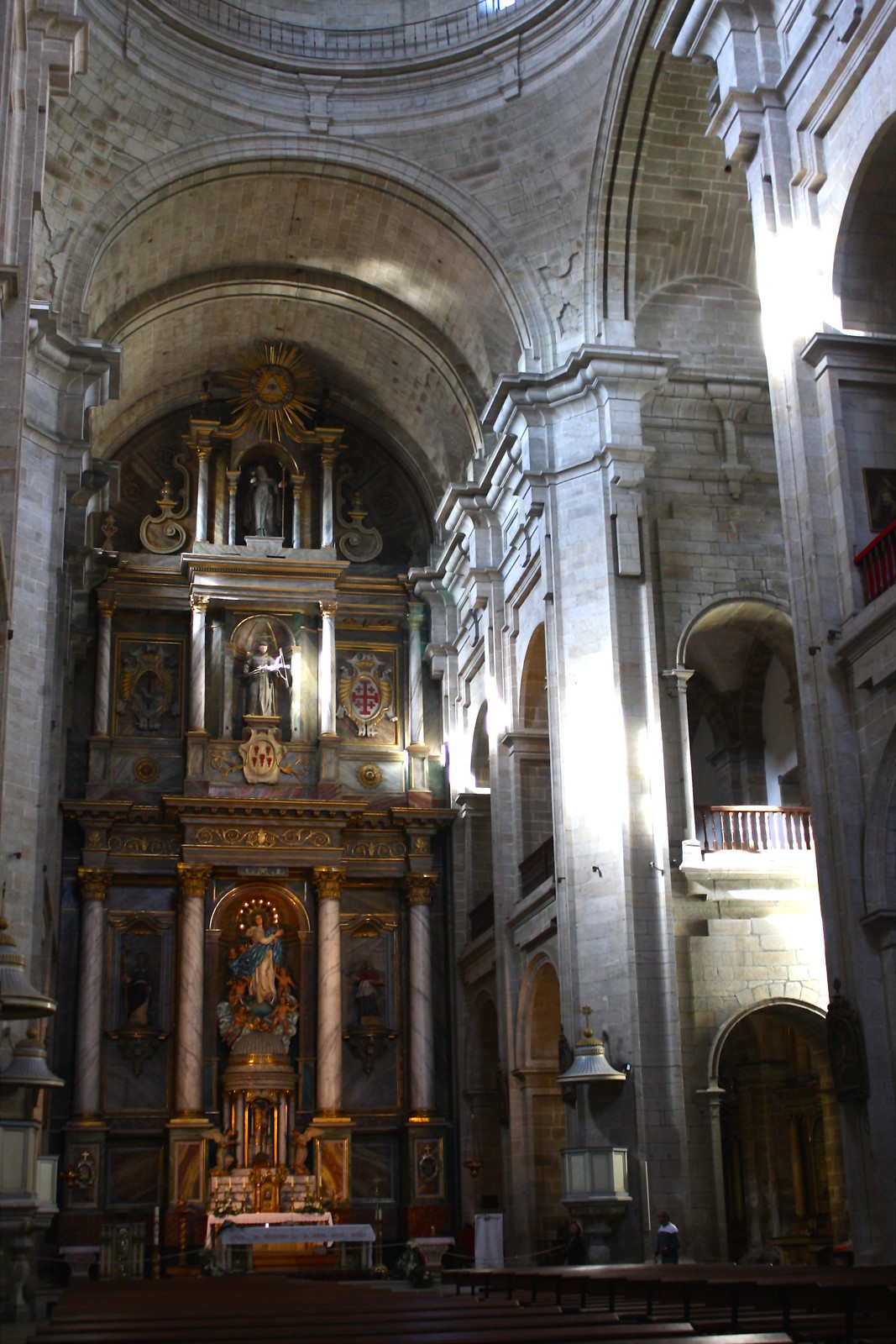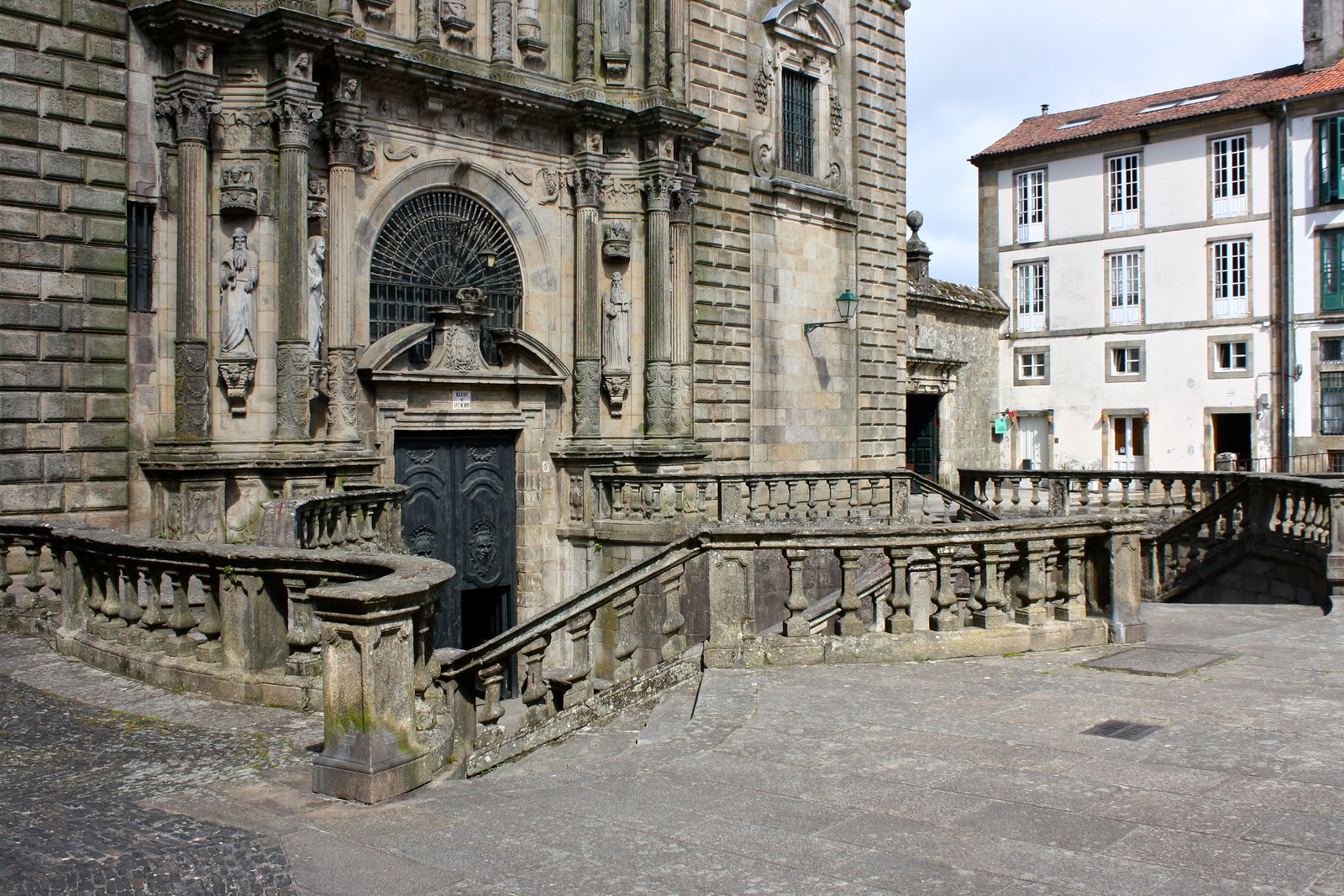Santiago de Compostela, the capital of Spain’s northwestern region of Galicia, is by no means a big city, reaching barely 100,000 on weekdays (and plummeting on weekends and school vacations when students go back home to
mamá). Its monumental old town, while impressive, is often overshadowed by the cathedral’s west façade, and the ugly new town has buildings of perhaps ten floors at most. Because of this I put the word “skyline” in scare quotes in this post’s title.
However, if you can manage to escape the tourist (and pilgrim) madness along Rúa do Franco south of the cathedral, you’ll likely find yourself in Santiago’s major public park,
the Alameda. Walking north along the grand, tree-lined esplanade called the
Paseo da Ferradura, you’ll eventually end up at a wide, semicircular
mirador, or lookout point. From this strategic location, you can take in the whole old town as it sprawls from north to south. You’ll notice that there is a lot more going on in Santiago’s old town than just the cathedral, though.
What are all those other bell towers and domes doing there?
It’s taken me a year of living here to finally figure out what tower belongs to which church, but in this post, I’ve identified the four major churches that show up in the old town’s skyline that you can see to the west in the Alameda Park.
Church of San Francisco
Founded by St. Francis of Assisi himself when he went on pilgrimage on the
Camino de Santiago, the Church of San Francisco belongs to a community of Franciscan monks dating back 800 years. The present-day church, however, was built as recently as 1749: a pure, soaring Baroque sanctuary. It’s interesting that the church is oriented north-to-south instead of the traditional east-to-west layout, but because the main entrance faces south, a huge window at the main entrance lets warm sunlight pour in at all hours of the day—an important feature in often gloomy Galicia. The bottom half of the church’s south façade was designed in the Baroque style, but the top half and the two bell towers are pure Classical Revival. I actually went to a beautiful Easter Sunday Mass here this year…since the cathedral was standing-room-only
outside.
Because Franciscan monks have historically been involved with Roman Catholic activity in the lands of modern-day Israel and Palestine, this church manages a
Holy Land Museum (
Museo da Terra Santa), with artifacts stretching from prehistoric times to the present day as well as a huge, exquisite model of the Church of the Holy Sepulchre, carved from cypress wood from Gethsemane. The Franciscans also operate a fancy four-star hotel and an upscale restaurant, but their affordable café beneath the cloisters offers a warm and cozy atmosphere.
Church of San Martiño Pinario
The Church of San Martiño Pinario is attached to what was once
Spain’s second-largest monastery but which today houses the
Seminario Mayor (Catholic seminary for priests) and an
hospedería or simple hotel for pilgrims and tourists alike. The south façade of the monastery, in the Praza da Inmaculada across from the cathedral’s north doors, creates a stately atmosphere and a fitting welcome for pilgrims walking their final steps on the Camino de Santiago.
The church itself is a really astonishing Baroque treasure that competes with the cathedral. It’s a bit of a walk to reach it from the monastery side of things, but once you get there, you have to simply stop to take it all in. An ornamented Plateresque façade acts almost like an altarpiece for faithful Catholics, who must reach the below-ground-level west doors via a swirling double staircase that cuts into the plaza. The church functions today as the diocesan museum, but that hardly detracts from the
heavenly interior that rivals the cathedral in beauty. Vast barrel vaults reach high and shed lots of light on an unbelievably sized wooden altarpiece just dripping in gold leaf. As part of the museum entrance fee, you can also go up to the balcony, where the cathedral’s Renaissance-era wooden choir stalls were moved to in the 1950s.
Church of San Paio de Antealtares
Accessible around the corner from the expansive Praza da Quintana, San Paio de Antealtares has been around nearly along as the cathedral itself. Benedictine monks originally settled here to look after the veneration of St. James (hence the name
antealtares or “before the altar”), but they were followed in 1499 by Benedictine nuns, who established what would become the most prestigious convent in Galicia. Only forty nuns live here today. Still, you can go up to their revolving door and purchase
artisanal sweets like
tarta de Santiago (almond cake),
pastas de té (shortbread cookies), or
almendrados (chewy almond cookies).
The church attached to the convent is laid out in a Greek cross plan, that is, all the “arms” of the interior space are the same length—rare in Galicia. An expansive dome with an oculus window at the top (along the lines of Rome’s Pantheon) rests stately upon pendentives which together create a grand atmosphere. The nuns also manage the
Museum of Religious Art (
Museo de Arte Sacro) that guards the original altar used in the earliest basilicas dedicated to St. James.
Church of Santo Agostiño
I like to think of this church as the “market church” since it stands due north of Santiago’s excellent
mercado de abastos. In the mornings, when the market is open for business, older ladies from the villages who don’t rent spots inside the market halls sit along the south side and the west entrance to this church and peddle their just-pulled-from-the-ground potatoes, homemade wine and liqueurs, glistening greens, and flaky onions.
The bell tower is one of the most distinctive in the city: the right tower was never completed and the left one was
struck by lightning in 1788 and never rebuilt! The church (and the attached monastery) were originally ministered to by Augustinian monks, but today, the Jesuits run a university dormitory in the building.
Which church would you be most interested in checking out if you visited Santiago? Tell me which one you liked the best below in the discussion thread!












